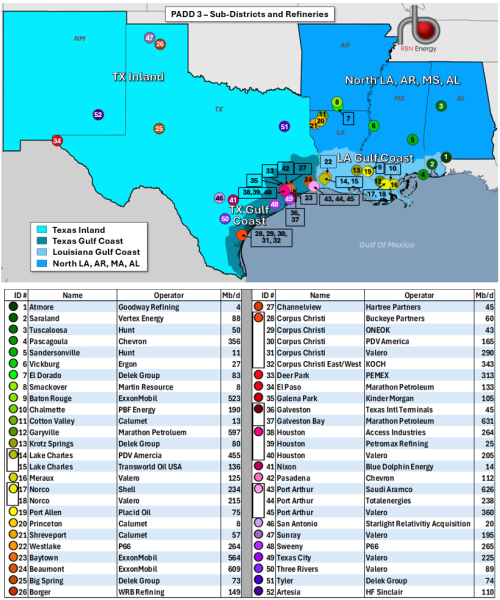PADD 3 has it all — crude oil production from the prolific Permian Basin, a string of refineries along the Gulf Coast, and a fair bit of refined product consumption. Its importance in crude oil production and refining has allowed it to play a central role in the nation’s crude oil supply-and-demand balance. This is especially true regarding crude oil exports, as it’s responsible for virtually all of the U.S. total that can top 4 MMb/d. Because of this, PADD 3 has a significant and growing influence in balancing domestic and international markets for crude oil and refined products. In today’s RBN blog, we’ll look at how the Shale Revolution has transformed the Gulf Coast and how its connectedness with international markets has reaffirmed its dominant position.
In Part 1 of this series, we explained how the U.S. is divided between five Petroleum Administration for Defense Districts, or PADDs, with PADD 1 representing the East Coast. With no production to call its own, PADD 1 relies on imported crude oil to supply its shrinking refinery base. But PADD 1’s population density also makes it the largest consumer of refined products. In Part 2, we put the spotlight on PADD 2 and how the looming threat of a 10% tariff on U.S. imports of Canadian crude oil might impact refineries in the Midwest/Great Plains. PADD 2 pipelines transport most Canadian exports, and its 25 refineries (combined capacity of 4.3 MMb/d) are, in many cases, significant consumers of heavy and light crudes from the Great White North.
Today’s blog puts the focus on PADD 3 and the critical role it plays in balancing crude oil and refined products markets. Of the ~10 MMb/d of refinery capacity in PADD 3, 5.5 MMb/d is situated in the Texas Gulf Coast sub-district (dark-teal area in Figure 1 below) with an additional 3.4 MMb/d in the Louisiana Gulf Coast region (light-blue area). That means ~90% of the entire PADD’s refining capacity is situated along the Gulf of Mexico, and these refineries aren’t there for the pristine beaches or the good weather. Their position gives them access to major crude oil import docks. That’s a major difference between PADD 3 and the noncoastal PADD 2, which relies heavily on feedstock from other regions, especially Canada.
Figure 1. PADD 3 Refinery Map and Refinery Capacities. Source: RBN
Note: Colored Circles Indicate Refinery Locations
Join Backstage Pass to Read Full Article









